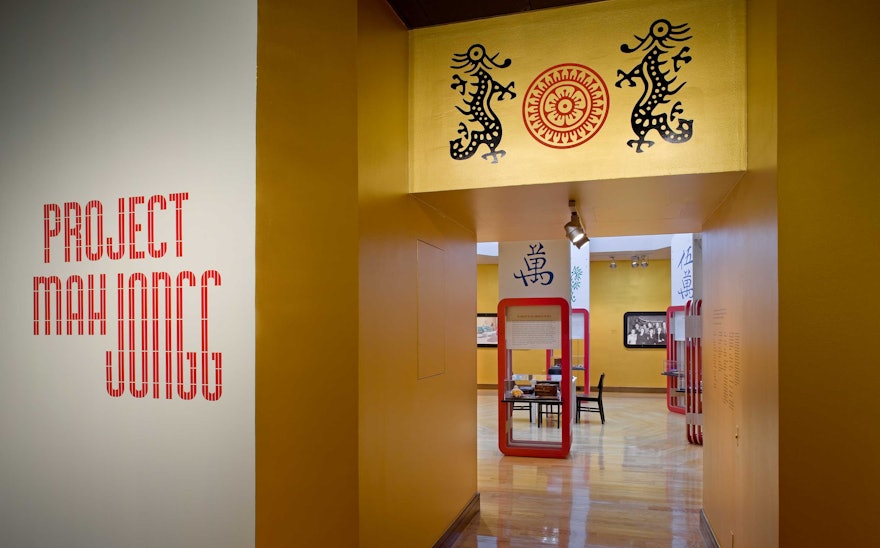For an ancient Chinese game legendarily invented by Confucius in the year 500 B.C., mah jongg enjoyed an extraordinary efflorescence in 20th century America, where it became a cultural phenomenon and fixture in Jewish-American communities. Pentagram has designed Project Mah Jongg an exhibition at the Museum of Jewish Heritage in New York that explores the traditions, history and meanings of the game in Jewish-American culture. Pentagram has also edited and designed a book called Mah Jongg: Crak, Bam, Dot!, published by 2wiceBooks, that serves as a companion to the exhibition.
The designers worked closely with museum curator Melissa J. Martens to create a visual narrative of mah jongg’s unusual hybridization of Jewish and Chinese cultures. The game became an enormously popular fad in the U.S. after sets were first imported in the 1920s. This coincided with a period of national immigration restrictions, and mah jongg’s foreign associations stirred both intrigue and stereotypes in the press. It gained a reputation as a “vice,” a gambling game and sign of rebellious flapper behavior. But in Jewish communities, it was perfect for women’s gatherings and fundraisers, where the rule cards were sold for charity. After World War II, the game became a staple of bungalow colonies in the Catskills and suburban Jewish homes, and it is still played by hundreds of thousands of people today.
With its iconic tiles, graphic symbols and colorful material culture, mah jongg holds special appeal for designers. Project Mah Jongg was designed to take advantage of the museum’s Rotunda Gallery, a 1,000-square-foot hexagonal room with a 40-foot-high skylight at its center. The design combines Jewish and Asian cultural references, most notably in a structural frame installed under the gallery’s apex, where a Jewish star has been highlighted within an interlocking Chinese pattern. A series of towers—designed to adjust height depending on the context—resemble stacks of giant mah jongg tiles set on end. The towers incorporate display cases for artifacts, and feature graphics derived from the game. At the center of the gallery is a table where visitors can play pick-up games during the show’s run. The exhibition is accompanied by an ambient sound installation by Timothy Nohe that features clicking tiles, sounds of gossip and exclamations of “crak,” “bam” and “dot, ” terms used in the game.
Artifacts and ephemera include objects from the mah jongg craze of the 1920s, including vintage advertisements, Chinoiserie, early game sets distributed by companies such as Milton Bradley and Parker Brothers, manuals, rulebooks and images of the National Mah Jongg League. Pentagram commissioned a group of guest artists to interpret the game through their distinct sensibilities. Fashion designer Isaac Mizrahi sketched mah jongg-inspired ensembles; Maira Kalman illustrated a “mah jongg murder mystery”; Bruce McCall created “Miami Mah Jongg,” juxtaposing ancient Chinese figures patiently tutoring a group of Jewish women; and Christoph Neimann designed new tile iconography combining the visual language of mah jongg with symbols of Jewish life.
These contributions also appear in Mah Jongg: Crak Bam Dot. The book also explores the connections between mah jongg and Jewish- and Chinese-American cultures, with essays by Jennifer 8. Lee, on the popularity of Chinese food with American Jews; Wendy Goodman, on the designer Tony Duquette; Paul Shaw, on ethnic typefaces; and Daniel Cappello, on the Chinese-American actress Anna May Wong. Portfolios highlight imagery from the mah jongg craze of the early 20th century; vintage sets, tiles and other ephemera; and fortunes from Chinese fortune cookies. The book has been designed with the proportions and rounded corners of a mah-jongg tile.

